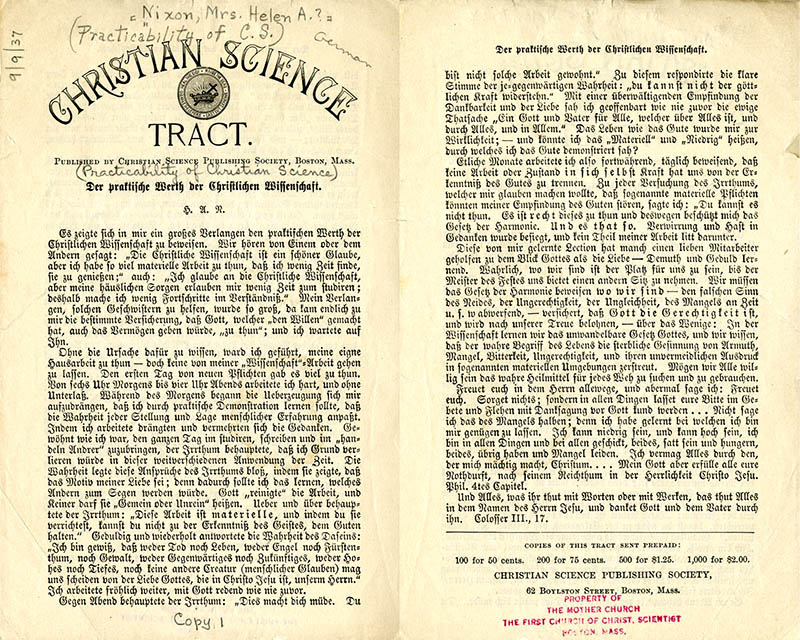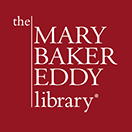The history of Christian Science in Germany: 1881 to 1896

The Christian Science movement in Germany started in the United States. That makes sense—Mary Baker Eddy, who discovered Christian Science, was American. While she herself never made a trip to Europe, her correspondence furnishes hints that her discovery began making its way across the ocean at an early date.
And why not? By the early 1880s transportation technology had greatly advanced, in the space of just a few decades. Crossing the Atlantic by ocean liner was becoming commonplace; people (as well as mail, including packages of books and pamphlets) could now travel from New York to Europe in less than a week, marking a huge improvement in both time and cost. Because of the relative ease of intercontinental travel, it’s possible that Germans first began to hear of Christian Science in the early 1880s.
The earliest record of German interest in Christian Science that we have been able to identify dates back to 1881, when Professor Johann Karl Friedrich Zöllner (1834–1882) received a copy of the 3rd edition of Eddy’s textbook on Christian Science, Science and Health. Zöllner was a professor of astrophysics at Leipzig University and known for his deep interest in spiritualism. The first edition of Science and Health had been published about six years earlier, in 1875. While it’s not entirely clear whether Zöllner ordered his books or received them as a gift, the record indicates that he acknowledged receipt of them (Science and Health was printed in two volumes at that time). Therefore we know that by 1881 Science and Health had at least one reader in Germany!1
From Eddy’s correspondence files, we also find examples of German interest in Christian Science—expressed by German speakers in the US. Not surprisingly that interest was centered in the American Midwest, where many German immigrants had settled and where Christian Science was becoming increasingly well-known. Just before Eddy’s first visit to Chicago in 1884, her student Caroline Noyes wrote this:
There is a German Gentleman of high Culture a Physician here [in Chicago] who stumbled across a set of your Books at a second hand store and became so greatly interested that he wrote a long article for the medical journal extolling the merits of it as far as he could gather them from the Book but he concluded it was rather severe on the Faculty and did not send it for publication – a Patient of mine who knows him related this to me and he is trying to have him come and see me and I shall try and get the article and send it to you.2
In a letter to Eddy later that year, Anna M. Steinmann of Grand Rapids, Michigan, wrote:
I am very much interested in this Science, it is so grand, of so wide a scope, & you must feel so happy in being permitted to do so much to advance it. May I ask a few questions? Who is the Author of this Science, was it never practiced until you started it? & is it the same that is making such headway in Germany? or did it originate there? The German mind seems especially adapted to metaphysics, as the researchers of the great authors show.3
Within a few years, it was clear that one challenge to the spread of Christian Science in Germany would be lingual; there was no Christian Science literature in any language but English. In the US, where thousands of German-speaking immigrants were now pouring in from Europe, this was also seen as an obstacle. In early 1888 one woman in New York asked, “I wanted to buy your book and what is the price of it and have you it translated in german too?”4
The following year the Christian Science movement’s monthly periodical, The Christian Science Journal, published a letter from “L.S.” of Oregon, Missouri, that mentioned the need for a translation:
… There were seven of us [who] went through a class here taught by A. F. [Alfred Farlow] We have a good Sabbath school which is held at our house at half past 2 p. m. The average attendance is from fifteen to twenty. We should have more than twice this number if some did not live so far out in the country, and some are Germans and cannot take part in our exercises. How often have I heard the Germans say, ‘If we could only get Science and Health in German so that we could learn better the principles of Christian Science.’ I hope the time is not far distant when Science and Health will be translated in the German language. Then many who are seeking after Truth will be able to find the pearl of great price….5
That was not the only Christian Scientist asking for translation. Earlier that year, Eddy’s pupil John Linscott had told her of his work in Christian Science in Winona, Minnesota. His patients were “all Germans” and he pushed for translation. “Many ask for the Book S.H. [Science and Health] in German print,” he wrote. “I think it would be wise to have a good tract written by yourself – printed in German.”6 That was the first year in which The Christian Science Publishing Society first produced tracts—leaflets, short in length and intended for free distribution. Eddy did not specifically reply to Linscott’s request, but in her next letter to him she wrote, “Your letter is just what I wanted to hear from you. ― Yes, you have taken the right course in proving your faith and understanding before launching out deeper, and perhaps beyond your depth….”7
The desire to share Christian Science with a more international audience must have become known to the Publishing Society, for a year later in February 1890 the Journal announced, “In response to a demand from different fields of labor, we have published [the tract] ‘The Way to Begin in Christian Science’ in German.” Within a few years more German tracts appeared: “There is Rest and Peace on Earth” (1892), “Freedom” (1892), and “Practicability of Christian Science” (1893).
Favorable response was almost immediate. One correspondent reported this in the Journal:
My correspondence in Christian Science brings the sense of Truth girding the earth. To-day, I have a strong Science letter from Paris; another comes from the far West; and still another full of triumph from a Southern worker. Now, I am writing to Ireland. Our tracts are enclosed and travelling with each one sent out. My thought also reaches a dear friend in India — a missionary, physician to the Rajah, whom the leaflet entitled, “The Way to Begin Christian Science,” is now inducing to look into the truth. In a day or two, I hope to mail some German leaflets to Berlin; also to other Germans here who are eagerly watching for them.—D. K., Albany, N. Y.8
A year later, there was already a need for more literature:
Is Science and Health translated, or to be translated, into the German language? How I desired such a copy in Berlin! Where the opportunity was offered me, in connection with my landlady, to introduce Christian Science to her—the first she had ever heard the term used. Notwithstanding the apparent limitation of foreign language, she knowing but little English, we began the reading from “Recapitulation.” There was a willing state of mind, and a consciousness of the presence of Spirit, giving light and understanding. One idea after another was presented, standing out beautifully to her apprehension. Then the uncompromising statements succeeded—contradicting every belief of a so-called life time. These were met with astonishment, and mortal-mind denial of their truthfulness; but, when the statement was made and proved that only from the standpoint of Christian Science are spiritual facts known—this was a revelation! A fortnight of occasional readings seems all too short; but, on coming to Dresden, I left with her the only German tract, “How to Begin in Christian Science,” together with a copy each, of Rudiments and Rules, and No and Yes, in English—intending, later, to send to London for a copy of Science and Health. She would require, according to her sense of things, some assistance in English to progress much; but I have already ordered a copy of Science and Health to be sent from London to Berlin, not knowing of any translation from it in German….9
In the August 1891 Journal, Eddy’s student Annie Dodge—an international traveler—listed locations where the new revised Science and Health (the 50th edition, in English) had been placed. The list included locations in Dresden and Berlin. In 1893 Hans Eckert, a German living in the US, became a member of The Mother Church in Boston. Returning to Germany in 1894, he became instrumental in the growth of Christian Science in Stuttgart.
But who would forward the expansion of Christian Science in Germany—Germans or Americans? Would literature be available in German, or only in English? Would there be church services—and would they be in German? These critical questions began to find answers when Laura Lathrop of New York City taught a 1896 Primary class in Christian Science healing. It included two pupils who would become critical in bringing Eddy’s discovery to Germany: Bertha Günther-Peterson and Frances Thurber Seal. The next installment of this article will talk about these remarkable women and the contributions they made.
- See Christian Scientist Association Account book 1881-1884, EOR29, 35.
- Caroline Noyes to Mary Baker Eddy, 10 April 1884, IC304.43.006.
- Anna M. Steinmann to Eddy, 27 December 1884, IC346.47.004. Steinmann was an American, but “educated mainly in Germany” according to her undated application for instruction at the Massachusetts Metaphysical College, L18439, 85.
- Rosa Kaiser to Eddy(?), 17 January 1888, L17834.
- “Open Letters,” The Christian Science Journal, August 1889, 263.
- John Linscott to Eddy, 10 February 1889, IC164aP1.28.016.
- Eddy to Linscott, 20 February 1889, L04112.
- “Notes from the Field,” Journal, March 1890, 601.
- “Germany,” in “Notes from the Field,” Journal, March 1891, 535.

